Critical Review on Efficiency of Ground Heat Exchangers in Heat Pump Systems
Abstract
:1. Introduction
1.1. Research Background
1.1.1. Open System
1.1.2. Closed System
1.1.3. Borehole Thermal Resistance
1.1.4. Thermal Response Test
2. Literature Review
- Effects of grout materials on the thermal performance of ground heat exchangers,
- Influence of different pipe configurations on the thermal performance of ground heat exchangers,
- Effects of borehole depths and diameters on the thermal performance of ground heat exchangers, and
- Miscellaneous issues related to performance of ground heat exchangers (e.g., ground heat transfer characteristics calculation methods; recovery time; performance in arctic/cold climate etc.)
2.1. Effects of Grout Materials on the Thermal Performance of Ground Heat Exchangers
2.2. Influence of Different Pipe Configurations on the Thermal Performance of Ground Heat Exchangers
2.3. Effects of Borehole Depths and Diameters on the Thermal Performance of Ground Heat Exchangers
2.4. Miscellaneous Issues Related to Performance of Ground Heat Exchangers
3. Critical Observations
4. Conclusions
Author Contributions
Funding
Conflicts of Interest
References
- Ozturk, M. Energy and exergy analysis of a combined ground source heat pump system. Appl. Therm. Eng. 2014, 73, 362–370. [Google Scholar] [CrossRef]
- ASHRAE. Heating, Ventilating, and Air-Conditioning Applications; American Society of Heating, Refrigerating and Air-Conditioning Engineers, Inc.: Atlanta, GA, USA, 2011. [Google Scholar]
- Fashina, A.; Mundu, M.; Akiyode, O.; Abdullah, L.; Sanni, D.; Ounyesiga, L. The drivers and barriers of renewable energy applications and development in Uganda: A review. Clean Technol. 2019, 1, 9–39. [Google Scholar] [CrossRef] [Green Version]
- Bishoge, O.K.; Zhang, L.; Mushi, W.G. The potential renewable energy for sustainable development in Tanzania: A review. Clean Technol. 2019, 1, 70–88. [Google Scholar] [CrossRef] [Green Version]
- Omer, A.M. Ground-source heat pumps systems and applications. Renew. Sustain. Energy Rev. 2008, 12, 344–371. [Google Scholar] [CrossRef]
- Sarbu, I.; Sebarchievici, C. General review of ground-source heat pump systems for heating and cooling of buildings. Energy Build. 2014, 70, 441–454. [Google Scholar] [CrossRef]
- Monzó, P. Comparison of Different Line Source Model Approaches for Analysis of Thermal Response Test in a U-Pipe Borehole Heat Exchanger. Master’s Thesis, KTH School of Industrial Engineering and Management, Stockholm, Sweden, June 2011. [Google Scholar]
- Mogensen, P. Fluid to duct wall heat transfer in duct system heat storages. Doc. Swed. Counc. Build. Res. 1983, 16, 652–657. [Google Scholar]
- Eklöf, C.; Gehlin, S. TED-a Mobile Equipment for Thermal Response Test: Testing and Evaluation. Master’s Thesis, Lulea University of Technology, Lulea, Sweden, June 1996. [Google Scholar]
- Austin, W.A., III. Development of an In situ System for Measuring Ground Thermal Properties. Ph.D. Thesis, Oklahoma State University, Stillwater, OK, USA, May 1998. [Google Scholar]
- Sanner, B.; Reuss, M.; Mands, E.; Müller, J. Thermal response test-experiences in Germany. In Proceedings of the Terrastock, Stuttgart, Germany, 28 August–1 September 2000; pp. 177–182. [Google Scholar]
- Remund, C.P. Borehole thermal resistance: Laboratory and field studies. ASHRAE Trans. 1999, 105, 439. [Google Scholar]
- Allan, M.L.; Kavanaugh, S.P. Thermal conductivity of cementitious grouts and impact on heat exchanger length design for ground source heat pumps. HVAC&R Res. 1999, 5, 85–96. [Google Scholar]
- Abu-Hamdeh, N.H.; Khdair, A.I.; Reeder, R.C. A comparison of two methods used to evaluate thermal conductivity for some soils. Int. J. Heat Mass Transf. 2001, 44, 1073–1078. [Google Scholar] [CrossRef]
- Pahud, D.; Matthey, B. Comparison of the thermal performance of double U-pipe borehole heat exchangers measured in situ. Energy Build. 2001, 33, 503–507. [Google Scholar] [CrossRef]
- Katsura, T.; Nagano, K.; Takeda, S.; Shimakura, K. Heat transfer experiment in the ground with ground water advection. In Proceedings of the 10th Energy Conservation Thermal Energy Storage Conference Ecostock, Pomona, NJ, USA, 31 May–2 June 2006. [Google Scholar]
- Gustafsson, A.M.; Westerlund, L. Multi-injection rate thermal response test in groundwater filled borehole heat exchanger. Renew. Energy 2010, 35, 1061–1070. [Google Scholar] [CrossRef]
- Lee, C.; Park, M.; Min, S.; Kang, S.H.; Sohn, B.; Choi, H. Comparison of effective thermal conductivity in closed-loop vertical ground heat exchangers. Appl. Therm. Eng. 2011, 31, 3669–3676. [Google Scholar] [CrossRef]
- Javed, S.; Spitler, J.D.; Fahlén, P. An experimental investigation of the accuracy of thermal response tests used to measure ground thermal properties. ASHRAE Trans. 2011, 117, 13–21. [Google Scholar]
- Alrtimi, A.A.; Rouainia, M.; Manning, D.A.C. Thermal enhancement of PFA-based grout for geothermal heat exchangers. Appl. Therm. Eng. 2013, 54, 559–564. [Google Scholar] [CrossRef]
- Lei, H.; Dai, C. Comparative experiment of different backfill grouts for concentric ground heat exchangers. Delta 2013, 37, 597–600. [Google Scholar]
- Erol, S.; François, B. Efficiency of various grouting materials for borehole heat exchangers. Appl. Therm. Eng. 2014, 70, 788–799. [Google Scholar] [CrossRef]
- Luo, J.; Rohn, J.; Xiang, W.; Bayer, M.; Priess, A.; Wilkmann, L.; Steger, H.; Zorn, R. Experimental investigation of a borehole field by enhanced geothermal response test and numerical analysis of performance of the borehole heat exchangers. Energy 2015, 84, 473–484. [Google Scholar] [CrossRef]
- Choi, W.; Ooka, R. Effect of natural convection on thermal response test conducted in saturated porous formation: Comparison of gravel-backfilled and cement-grouted borehole heat exchangers. Renew. Energy 2016, 96, 891–903. [Google Scholar] [CrossRef]
- Luo, J.; Tuo, J.; Huang, W.; Zhu, Y.; Jiao, Y.; Xiang, W.; Rohn, J. Influence of groundwater levels on effective thermal conductivity of the ground and heat transfer rate of borehole heat exchangers. Appl. Therm. Eng. 2018, 128, 508–516. [Google Scholar] [CrossRef]
- Lee, C. Thermal performance evaluation of a vertical closed-loop ground heat exchanger according to rock type in Korea. Energy Build. 2019, 183, 184–194. [Google Scholar] [CrossRef]
- Zeng, H.; Diao, N.; Fang, Z. Heat transfer analysis of boreholes in vertical ground heat exchangers. Int. J. Heat Mass Transf. 2003, 46, 4467–4481. [Google Scholar] [CrossRef]
- Acuña, J.; Palm, B. A novel coaxial borehole heat exchanger: Description and first distributed thermal response test measurements. In Proceedings of the World Geothermal Congress, Bali, Indonesia, 25–30 April 2010; p. 7. [Google Scholar]
- Guillaume, F. Analysis of a Novel Pipe in Pipe Coaxial Borehole Heat Exchanger. Master’s Thesis, KTH School of Industrial Engineering and Management, Stockholm, Sweden, June 2011. [Google Scholar]
- Beier, R.A.; Ewbank, G.N. In-Situ Test Thermal Response Tests Interpretations. OG&E Ground Source Heat Exchange Study; Oklahoma State University: Stillwater, OK, USA, 2012.
- Desmedt, J.; Van Bael, J.; Hoes, H.; Robeyn, N. Experimental performance of borehole heat exchangers and grouting materials for ground source heat pumps. Int. J. Energy Res. 2012, 36, 1238–1246. [Google Scholar] [CrossRef]
- Acuña, J. Distributed Thermal Response Tests: New Insights on U-Pipe and Coaxial Heat Exchangers in Groundwater-Filled Boreholes. Ph.D. Thesis, KTH Royal Institute of Technology, Stockholm, Sweden, April 2013. [Google Scholar]
- Bidarmaghz, A.; Narsilio, G.; Johnston, I. Numerical modelling of ground heat exchangers with different ground loop configurations for direct geothermal applications. In Proceedings of the 18th International Conference on Soil Mechanics and Geotechnical Engineering, Paris, France, 2–6 September 2013. [Google Scholar]
- Dincer, S.; Erdogan, C.; ve Ticaret, B.B.M.S.; Beldesi, A.O. Experimental measurement and long term predictions of a multi-U tube borehole performance for ground source heat pumps. In Proceedings of the 11th IEA Heat Pump Conference 2014, Montréal, QC, Canada, 12–16 May 2014. [Google Scholar]
- Haddada, J.; Miyara, A. Thermal performance and characteristics of spiral-tube ground heat exchanger for ground-source heat pump. In Proceedings of the International Heat Transfer Conference, Kyoto, Japan, 10–15 August 2014. [Google Scholar]
- Haddada, J.; Miyara, A. Performance investigation of multiple-tube ground heat exchangers for ground-source heat pump. Am. J. Energy Eng. 2014, 2, 103–107. [Google Scholar]
- Liu, X.; Xiao, Y.; Inthavong, K.; Tu, J. Experimental and numerical investigation on a new type of heat exchanger in ground source heat pump system. Energy Effic. 2015, 8, 845–857. [Google Scholar] [CrossRef]
- Yoon, S.; Lee, S.R.; Xue, J.; Zosseder, K.; Go, G.H.; Park, H. Evaluation of the thermal efficiency and a cost analysis of different types of ground heat exchangers in energy piles. Energy Convers. Manag. 2015, 105, 393–402. [Google Scholar] [CrossRef]
- Raymond, J.; Mercier, S.; Nguyen, L. Designing coaxial ground heat exchangers with a thermally enhanced outer pipe. Geotherm. Energy 2015, 3, 7. [Google Scholar] [CrossRef] [Green Version]
- Chang, K.S.; Kim, M.J. Thermal performance evaluation of vertical U-loop ground heat exchanger using in-situ thermal response test. Renew. Energy 2016, 87, 585–591. [Google Scholar] [CrossRef]
- Luo, J.; Zhao, H.; Gui, S.; Xiang, W.; Rohn, J.; Blum, P. Thermo-economic analysis of four different types of ground heat exchangers in energy piles. Appl. Therm. Eng. 2016, 108, 11–19. [Google Scholar] [CrossRef]
- Sáez Blázquez, C.; Farfan Martin, A.; Martin Nieto, I.; Carrasco Garcia, P.; Sánchez Pérez, L.; González-Aguilera, D. Efficiency analysis of the main components of a vertical closed-loop system in a borehole heat exchanger. Energies 2017, 10, 201. [Google Scholar] [CrossRef] [Green Version]
- Busso, A.; Georgiev, A.; Roth, P. Underground thermal energy storage–first thermal response test in South America. In Proceedings of the RIO 3-World Climate and Energy Event, Rio de Janeiro, Brazil, 1–5 December 2003; pp. 189–196. [Google Scholar]
- Florides, G.; Kalogirou, S. First in situ determination of the thermal performance of a U-pipe borehole heat exchanger, in Cyprus. Appl. Therm. Eng. 2008, 28, 157–163. [Google Scholar] [CrossRef]
- Sharqawy, M.H.; Said, S.A.; Mokheimer, E.M.; Habib, M.A.; Badr, H.M.; Al-Shayea, N.A. First in situ determination of the ground thermal conductivity for borehole heat exchanger applications in Saudi Arabia. Renew. Energy 2009, 34, 2218–2223. [Google Scholar] [CrossRef]
- Esen, H.; Inalli, M. Thermal response of ground for different depths on vertical ground source heat pump system in Elaziğ, Turkey. J. Energy Inst. 2009, 82, 95–101. [Google Scholar] [CrossRef]
- Beier, R.A.; Smith, M.D.; Spitler, J.D. Reference data sets for vertical borehole ground heat exchanger models and thermal response test analysis. Geothermics 2011, 40, 79–85. [Google Scholar] [CrossRef]
- Acuña, J.; Palm, B. Distributed thermal response tests on pipe-in-pipe borehole heat exchangers. Appl. Energy 2013, 109, 312–320. [Google Scholar] [CrossRef]
- Luo, J.; Rohn, J.; Bayer, M.; Priess, A. Thermal efficiency comparison of borehole heat exchangers with different drillhole diameters. Energies 2013, 6, 4187–4206. [Google Scholar] [CrossRef] [Green Version]
- Cimmino, M.; Bernier, M. Experimental determination of the g-functions of a small-scale geothermal borehole. Geothermics 2015, 56, 60–71. [Google Scholar] [CrossRef]
- Georgiev, A.G.; Popov, R.K.; Toshkov, E.T. In-situ measurements of ground thermal properties around borehole heat exchangers in Plovdiv, Bulgaria. Bulg. Chem. Commun. 2016, 48, 19–26. [Google Scholar]
- Yavuzturk, C.; Spitler, J.D.; Rees, S.J. A transient two-dimensional finite volume model for the simulation of vertical U-tube ground heat exchangers. ASHRAE Trans. 1999, 105, 465–474. [Google Scholar]
- Li, Z.; Zheng, M. Development of a numerical model for the simulation of vertical U-tube ground heat exchangers. Appl. Therm. Eng. 2009, 29, 920–924. [Google Scholar] [CrossRef]
- Khalajzadeh, V.; Heidarinejad, G.; Srebric, J. Parameters optimization of a vertical ground heat exchanger based on response surface methodology. Energy Build. 2011, 43, 1288–1294. [Google Scholar] [CrossRef]
- Javed, S.; Claesson, J.; Beier, R. Recovery times after thermal response tests on vertical borehole heat exchangers. In Proceedings of the 23rd IIR International Congress of Refrigeration, Prague, Czech Republic, 21–26 August 2011. [Google Scholar]
- Meyer, J.; Pride, D.; O’Toole, J.; Craven, C.; Spencer, V. Ground Source Heat Pumps in Cold Climates; Alaska Center for Energy and Power Cold Climate Housing Research Center: Fairbanks, AK, USA, 2011. [Google Scholar]
- Garber-Slaght, R.; Daanen, P.R.; Roe, P.A. Ground source heat pump efficiency in cold climates. In Proceedings of the Conference Paper Session-Ground Source Heat Pump System, Seattle, WA, USA, 1 July 2014. [Google Scholar]
- Lhendup, T.; Aye, L.; Fuller, R.J. In-situ measurement of borehole thermal properties in Melbourne. Appl. Therm. Eng. 2014, 73, 287–295. [Google Scholar] [CrossRef]
- Salim Shirazi, A.; Bernier, M. A small-scale experimental apparatus to study heat transfer in the vicinity of geothermal boreholes. HVAC&R Res. 2014, 20, 819–827. [Google Scholar]
- Soriano, G.; Villanueva, R.; González, I.; Montero, A.; Cornejo, M. First in situ measurement of soil thermal response in Guayaquil, Ecuador. WIT Trans. Ecol. Environ. 2015, 195, 327–336. [Google Scholar]
- Başer, T.; Lu, N.; McCartney, J.S. Operational response of a soil-borehole thermal energy storage system. J. Geotech. Geoenviron. Eng. 2015, 142, 04015097. [Google Scholar] [CrossRef] [Green Version]
- Zhang, L.; Zhang, Q.; Huang, G. A transient quasi-3D entire time scale line source model for the fluid and ground temperature prediction of vertical ground heat exchangers (GHEs). Appl. Energy 2016, 170, 65–75. [Google Scholar] [CrossRef]
- Yu, Y.; Miao, R.; Miller, L.; Yang, H.; Olson, G. Recent Development and Application of Geothermal Heat Pump Systems in Cold-Climate Regions of the US: A Further Investigation. Engineering 2017, 9, 625. [Google Scholar] [CrossRef]
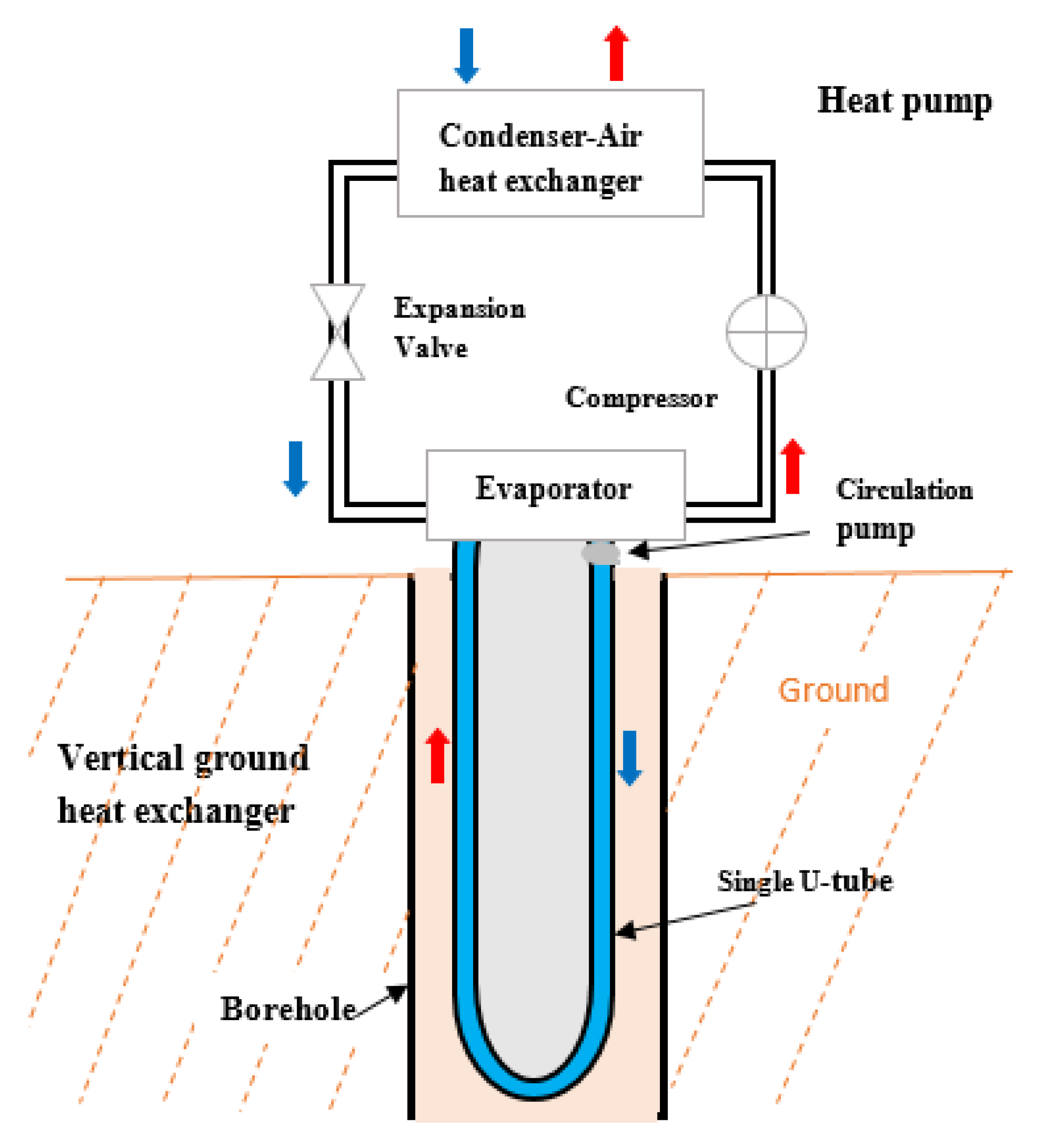
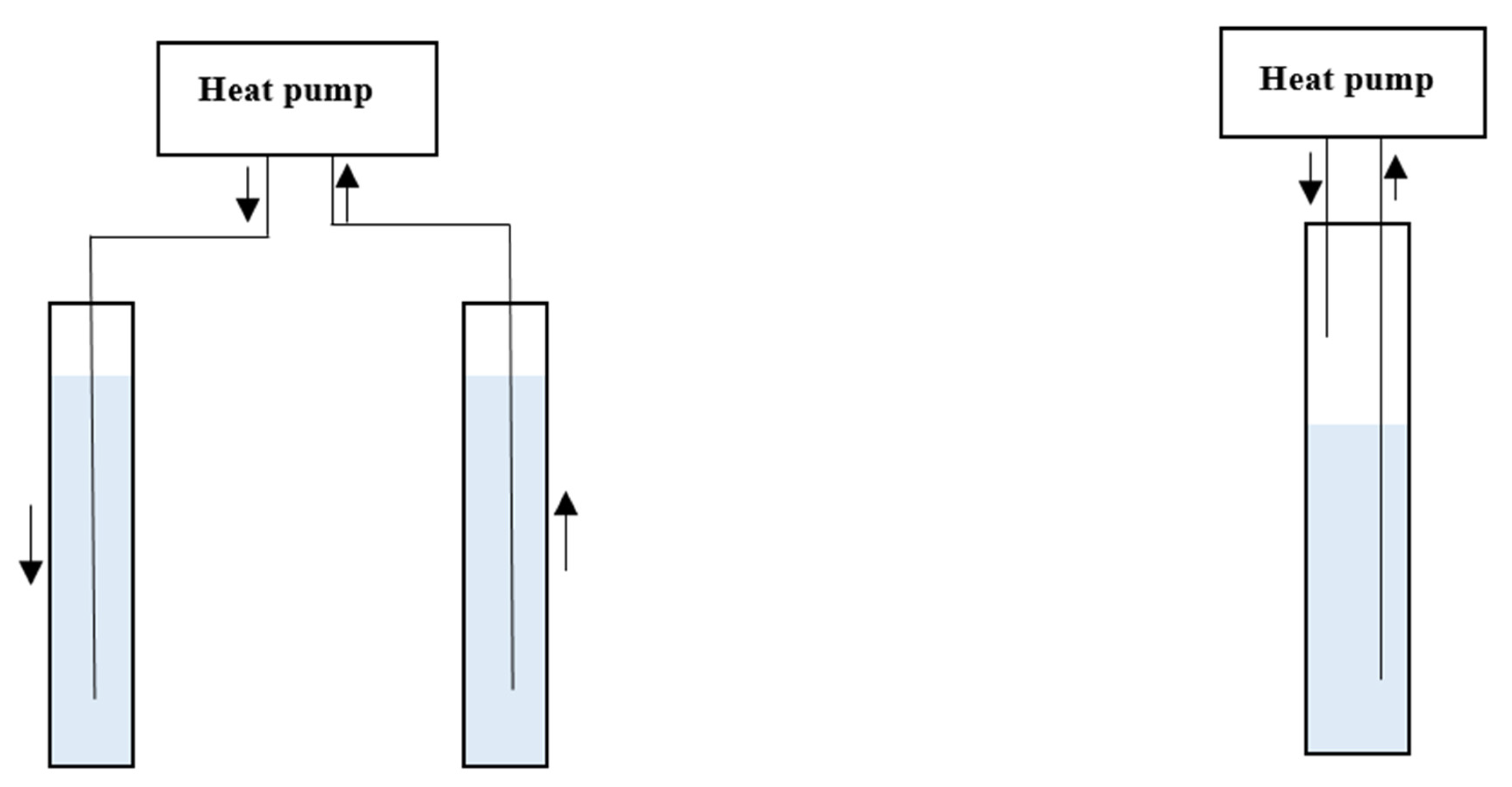



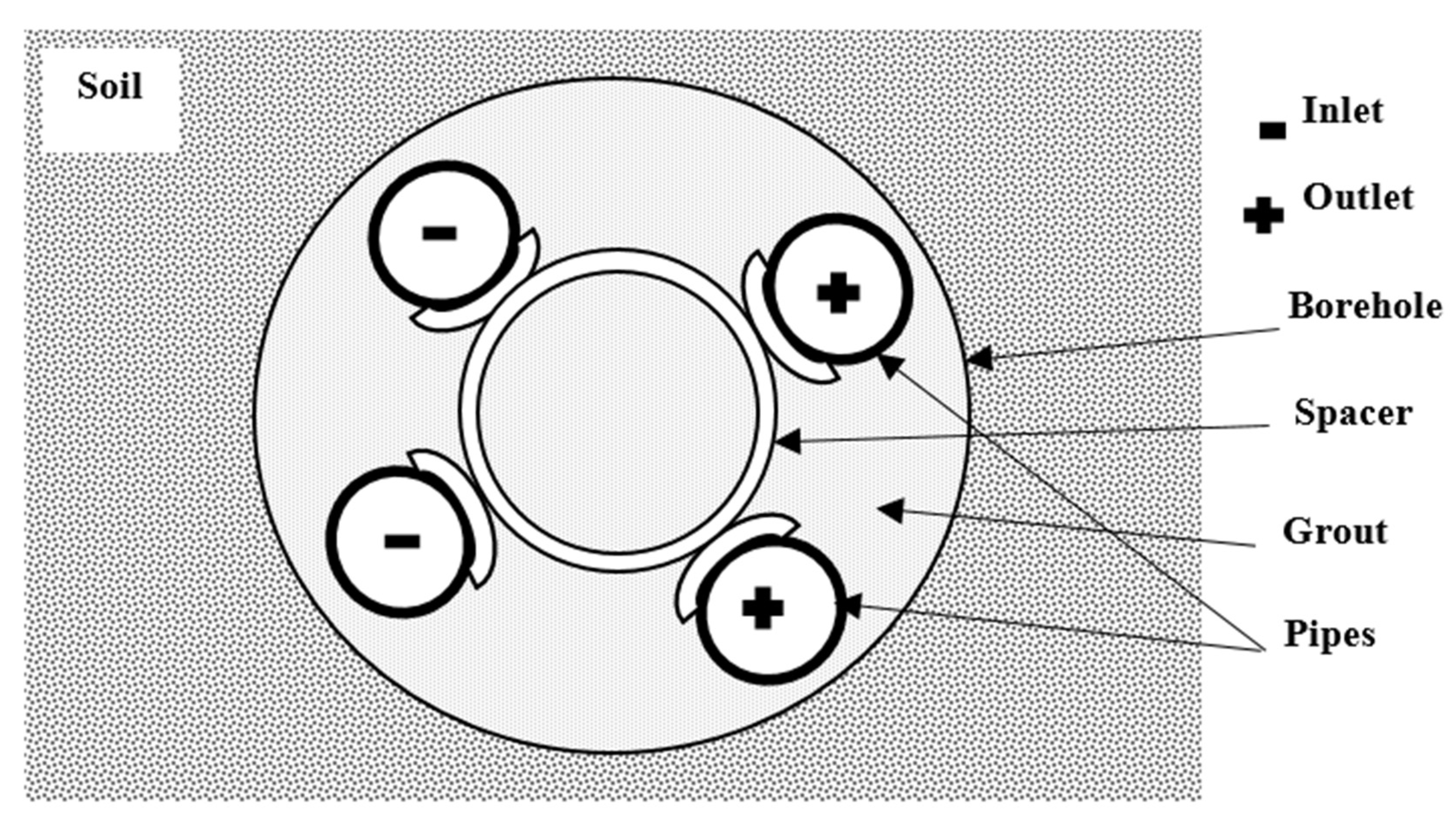
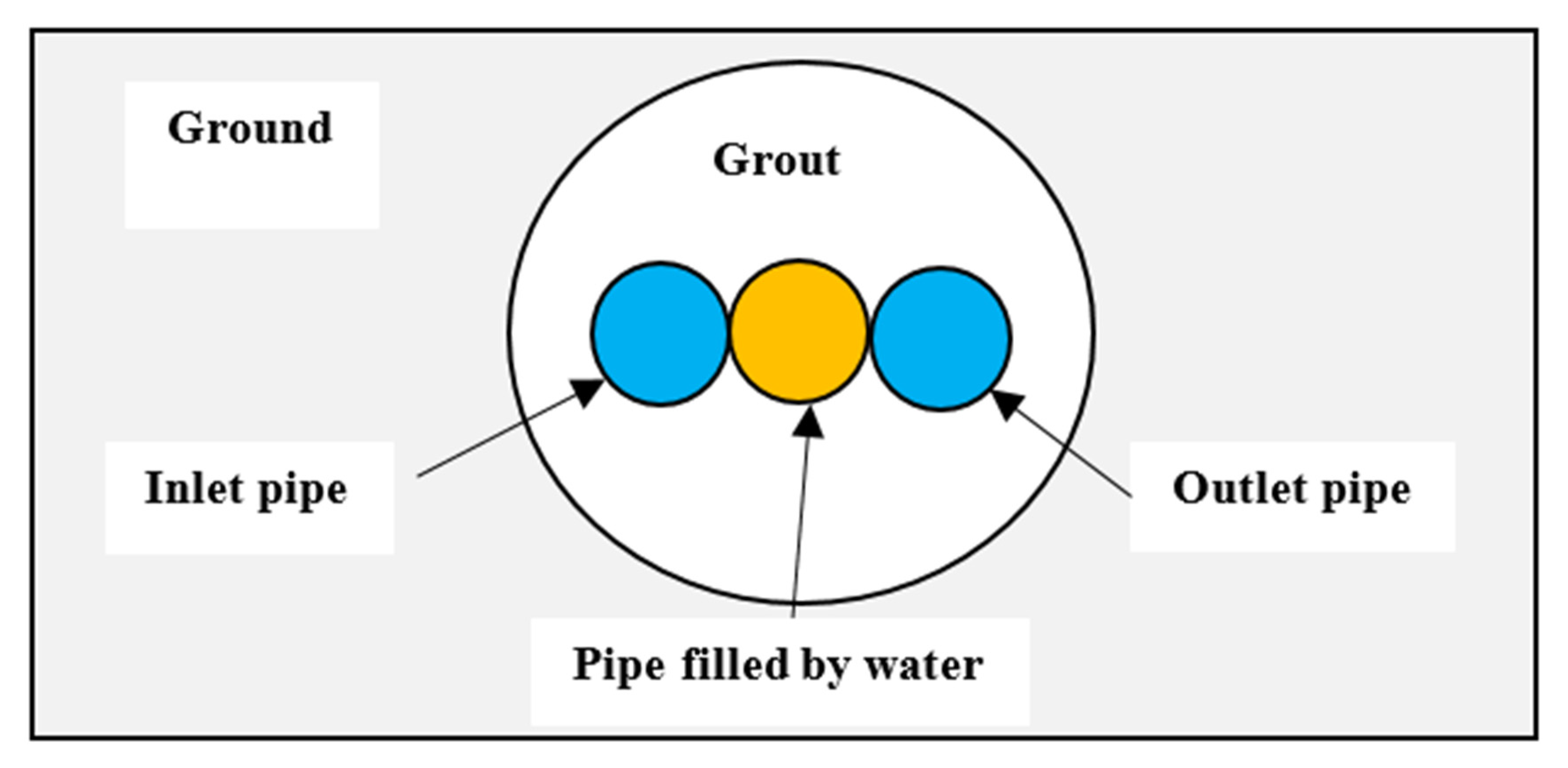


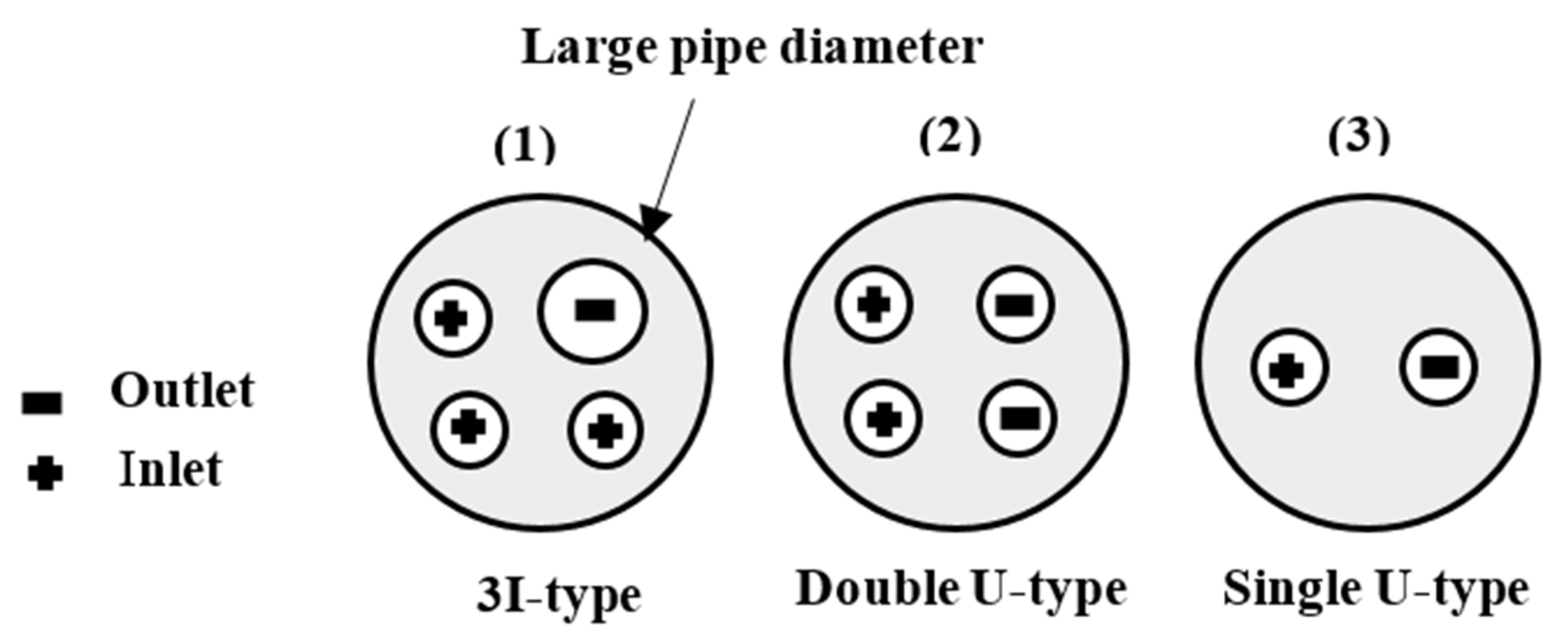


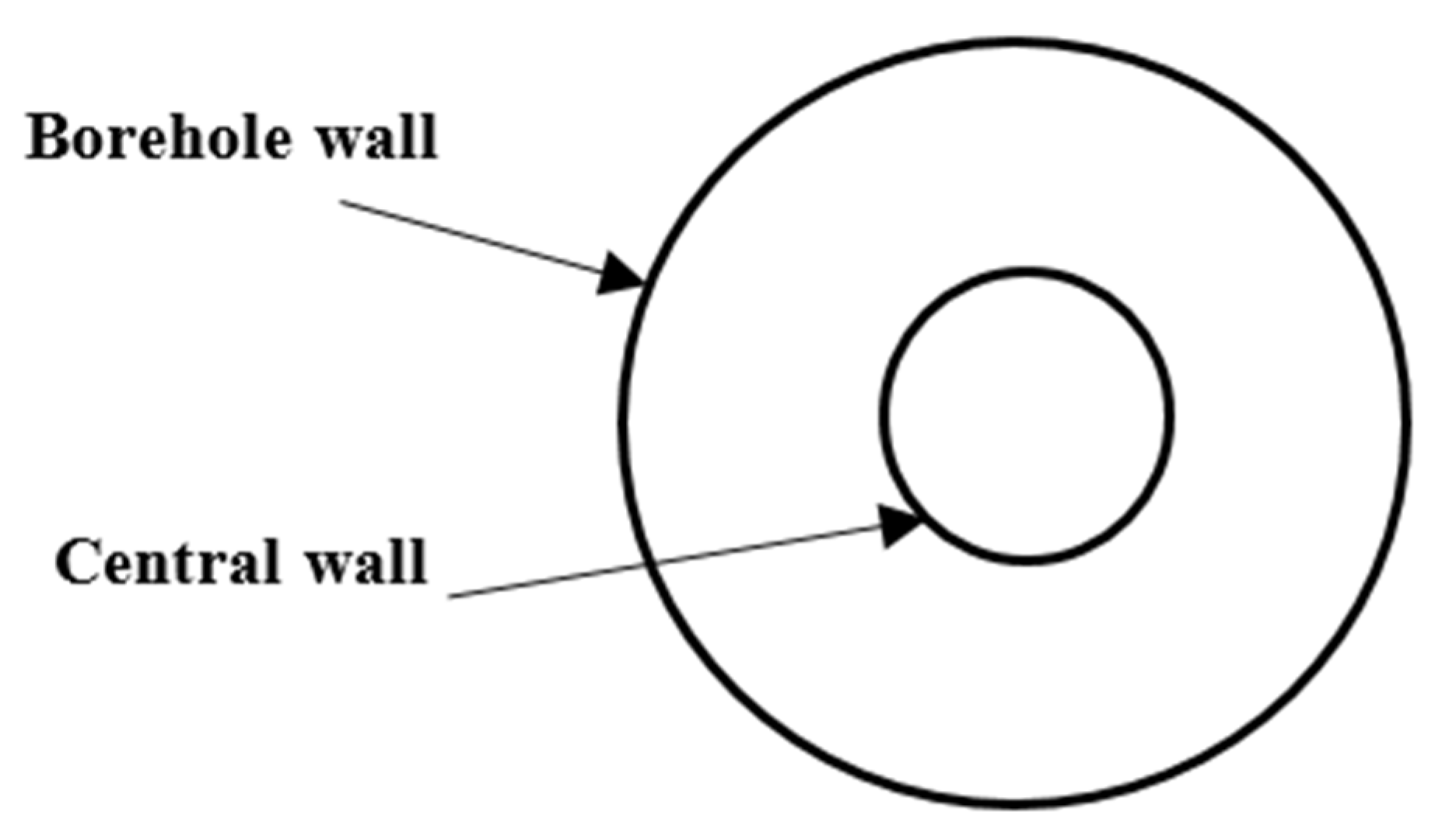

| Source | Description | Conclusion/s or Observation/s |
|---|---|---|
| Remund C. P (1999) [12] | Investigated the impacts of grout on the effective borehole thermal resistance. | Increased thermal conductivity of grout reduced the borehole thermal resistance. |
| Allan and Kavanaugh (1999) [13] | Studied how cement-sand, bentonites, and neat cements grout would affect the borehole length. | Borehole length decreased cement-sand was used as grout compared to bentonites and neat cements. |
| Abu-Hamdeh et al. (2001) [14] | Examined the effects of bulk density and moisture content on the thermal conductivity of some Jordanian soils. | Soil thermal conductivity increased with the increase of soil density and moisture content. |
| Pahud and Matthey (2001) [15] | Estimated the effects of bentonite, 50% sand and bentonite, and quartz sand, with and without spacers. | The quartz sand and spacers was the best option to increase the efficiency. The borehole thermal resistances with spacers was less than the same without spacers. |
| Katsura et al. (2006) [16] | Evaluated the influence of ground water flow on the heat transfer in the GHEs. | The effective thermal conductivity increased with an increase in the ground water velocity. |
| Gustafsson and Westerlund (2010) [17] | Considered the effects of the convective heat flow on the heat transfer in the GHEs. | In the solid bedrock, the borehole thermal resistance decreased when the convective heat flow increased. The heat flow through fractured bedrock increased with increased convective heat flow. |
| Lee et al. (2011) [18] | Estimated the thermal efficiency of GHEs with U-loop and 3-pipe. | The thermal efficiency of 3-pipe configuration was higher than U-loop. |
| Alrtimi et al. (2013) [20] | Proposed new grout mixtures which were produced from industrial waste such as pulverized fuel ash (PFA) to improve the heat transfer characteristics of the borehole heat exchangers. | The thermal conductivities of fluorspar and coarse sand, all with 20% of PFA were the highest thermal conductivities compared to other grouts. |
| Lei and Dai (2013) [21] | Compared phase change materials and sand-soil. | The soil temperature oscillates less with PCMs grouts than with sand-soil grout. |
| Erol and François (2014) [22] | Examined the silica sand-based, the bentonite-based, and homemade admixture as grout in the GHE. | The homemade admixture with 5% natural graphite was the best option as grout in the GHE. |
| Luo et al. (2015) [23] | Estimated the performance of heat transfer characteristic of the GHEs with and without groundwater flow. | The convection flow in groundwater led to increased heat transfer between GHE and the ground. |
| Choi and Ooka (2016) [24] | Studied the influences of cement-grout and gravel-backfill on the borehole thermal resistance of GHEs. | The borehole thermal resistance of the GHE with gravel-backfill was lower than the same with cement-grout. |
| Luo et al. (2018) [25] | Examined the effects of the groundwater level on effective ground thermal conductivity and heat transfer rate of GHEs. | The effective ground thermal conductivity and heat transfer rate of borehole heat exchangers increased with increasing level of the groundwater. |
| Lee C (2019) [26] | Studied the effects of different rock types (alluvial deposit, granite, and gneiss) and borehole depths (150 m and 200 m) on the effective ground thermal conductivity. | The effective ground thermal conductivity increased by increasing the borehole depth. The gneiss had the maximum effective ground thermal conductivity. |
| Zang et al. (2003) [27] | Developed a novel quasi-three-dimensional model to estimate ground properties. | The double U-tube has a thermal resistance lower than the single U-tube. |
| Acuña and Palm (2010) [28] | Suggested a new configuration to improve the thermal performance of GHE. | The performance of the heat transfer in a new configuration (pipe in pipe) is better than the U-tube. |
| Guillaume F (2011) [29] | Introduced a new approach of coaxial GHE with external insulation around the central pipe. | The heat extracted from the ground by using coaxial GHE with insulation was higher than the same for without insulation. |
| Beier and Ewbank (2012) [30] | Performed TRTs for GHEs with different pipe configurations (coaxial, double U-tube, and single U-tube). | The thermal resistance of borehole was the least when pipe configuration was double U-tube. |
| Desmedt et al. (2012) [31] | Estimated the impact of coaxial, single U-tube, and double U-tube on the borehole thermal resistance of GHEs. | The thermal resistance of the double U-tube was lower than single U-tube type, and coaxial type. |
| Acuña J (2013) [32] | Used a new method to study the effects of different volumetric flow rates on the performance of GHEs. | The temperature difference between pipes increased due to the decline of the flow rates. |
| Bidarmaghz et al. (2013) [33] | Estimated the effects of the fluid flow rate on the thermal performance of GHEs. | The thermal performance in GHEs improved by using turbulent flow and increasing the flow rate in pipes. |
| Dincer et al. (2014) [34] | Estimate the performance of single U-tube, double U-tube, and triple U-tubes of GHEs. | The performance of triple U-tube was higher than the double U-tube and single U-tube. |
| Haddada and Miyara (2014a) [35] | Compared the performance of U-tube and spiral-tube GHEs in both laminar and turbulent flow conditions. | In the laminar flow, the performance of the spiral-tube increased by 62.7%, and in the turbulent, it increased by 33.5%, while compared with the single U-tube. |
| Haddada and Miyara (2014b) [36] | Estimated the performance of different pipe configurations in GHEs. | The heat exchange rate increased between the boreholes and the ground due to increased number of inlet tubes in borehole. |
| Liu et al. (2015) [37] | Compared the influence of single U-tube, double U-tube, and a new design which has three inlet pipes and one outlet (3Itype) on the borehole thermal resistance. | The borehole thermal resistance of the 3Itype was lower than the double U-tube and the single U-tube. |
| Yoon et al. (2015) [38] | Estimated the thermal efficiency of two types GHEs: coil-type and W-type. | Coil-type had a higher heat exchange efficiency than the same for W-type. |
| Raymond et al. (2015) [39] | Preformed analytical models for two coaxial pipe configurations with different borehole diameters to reduce the depth of the borehole. | The borehole thermal resistance of the coaxial GHEs decreased due to an increase in the thermal conductivity of the outer pipe. |
| Chang and Kim (2016) [40] | Evaluated the effects of increasing number of tubes and tube diameters on the performance of GHEs. | Increasing number of tubes and using large tube diameter in the borehole leads to increased heat transfer in GHEs. |
| Luo et al. (2016) [41] | Compared the thermal efficiency of four types GHEs: double-U, triple-U, double-W, and spiral. | Tripe-U type was the best option. |
| Blázquez et al. (2017) [42] | Studied the impact of single and double U-tube (with or without spacers), and spiral pipes on the efficiency of GHEs. | The performance of the U-tube VGHEs with spacers was superior to the same without spacers. |
| Busso et al. (2003) [43] | Conducted the first thermal response test in Latin America to evaluate ground properties. | There were agreements between the experimental results and the numerical results. |
| Florides and Kalogirou (2008) [44] | Conducted the first thermal response test in Cyprus to evaluate ground properties. | Thermal conductivity for the ground was found to be 1.605 W/m. K and borehole thermal resistance was 0.257 m. K/W. |
| Sharqawy et al. (2009) [45] | Conducted the first field study in Saudi Arabia to calculate the ground thermal properties. | The mean undisturbed ground temperature was 32.6 °C. |
| Esen and Inalli (2009) [46] | Compared the thermal performance of the single U-tube GHEs with different depths. | The thermal performance increased with increased depths. |
| Beier et al. (2011) [47] | Designed a large laboratory sand tank to verify the heat transfer in and around the GHE. | Thermal response tests results were compared with several borehole models. |
| Acuña and Palm (2013) [48] | Developed a novel approach to determine the ground properties of the GHE at different depths. | The borehole thermal resistance of the coaxial pipe was lower than the same for single U-tube. |
| Luo et al. (2013) [49] | Preformed field studies to investigate the effects of different borehole diameters on the thermal efficiency of GHEs. | The results showed that the larger diameter leads to an increase in the heat transfer rate. |
| Cimmino and Bernier (2015) [50] | Conducted laboratory study to measure the borehole wall temperature during the thermal response test and reach steady state. | The temperature at borehole wall increased with increased duration of the thermal response test. |
| Georgiev et al. (2016) [51] | Compared temperature data collected during two thermal response tests in the same area and at different times. | Very small difference between temperature data collected during 2001 and 2012. |
| Yavuzturk et al. (1999) [52] | Developed numerical model to determine conduction heat transfer in and vicinity of single U-tube ground heat exchanger. | Very small difference between the numerical and analytical results. |
| Li and Zheng (2009) [53] | Developed a 3D numerical model to predict the outlet water temperature for single U- tube GHE. | The experimental and numerical models result showed close agreement for the outlet water temperature. |
| Khalajzadeh et al. (2011) [54] | Used a three dimensional CFD simulation to predict complex heat transfer process and the response variables. | There was a small difference between the numerical and experimental outputs for the outlet of fluid temperature. |
| Javed et al. (2011b) [55] | Measured the rest period for the borehole needed after the test to return to the initial ground temperature. | The rest time increased with increases both in the time and the rate of the heat injection |
| Meyer et al. (2011) [56] | Installed a number of residential-size ground source heat pumps in cold climates to study the performance of GSHPs. | The ground source heat pumps were found to be effective in cold climates, and the COP varied between 2.0 and 3.5. |
| Garber-Slaght et al. (2014) [57] | Installed a residential-size ground source heat pump to study the impacts of extracted heat over a period of three months on the ground thermal properties and any decline in heat pump system efficiency. | The results showed that the surrounding soil temperature is higher than the soil temperature around the ground heat exchanger and the COP of the heat pump was 3.3. |
| Lhendup et al. (2014) [58] | Performed four field tests on two boreholes with different depth to evaluate the ground properties of GHEs. | The field test results were compared with results obtained from three different methods. |
| Shirazi and Bernier (2014) [59] | Compared numerical and experimental results. | There were agreements between the experimental and numerical results. |
| Soriano et al. (2015) [60] | Performed the first field to estimate the soil thermal response in Guayaquil, Ecuador | The soil temperature was in the range of 27 to 29 °C. |
| Başer et al. (2015) [61] | Carried out a field test to estimate the distribution of undisturbed ground temperature during the period a of heat injection in underground thermal energy storage system. | The undisturbed ground temperature was increased by 7 °C. Four months later, it was noticed that the heat storage was decreased by 60%. |
| Zhang et al. (2016) [62] | Developed a novel transient quasi-3D whole time scale line source model, which characterized transient borehole thermal resistance and examined the heat flux profile along the two legs of the U- tube. | The modelling results were compared with experimental sandbox. The errors for the inlet and outlet fluid temperature were less than 5%. |
| Yu et al. (2017) [63] | Investigated the performance of GSHPs installed in 24 buildings in cold climate zones of the United States (US). | The overall performance of the GSHPs used in cold climate regions was slightly better (≈6.1% lower energy consumption and ≈7.2% lower in cost) compared to the national median of energy use and energy cost of typical buildings of the same type nationwide (US). |
© 2020 by the authors. Licensee MDPI, Basel, Switzerland. This article is an open access article distributed under the terms and conditions of the Creative Commons Attribution (CC BY) license (http://creativecommons.org/licenses/by/4.0/).
Share and Cite
Eswiasi, A.; Mukhopadhyaya, P. Critical Review on Efficiency of Ground Heat Exchangers in Heat Pump Systems. Clean Technol. 2020, 2, 204-224. https://doi.org/10.3390/cleantechnol2020014
Eswiasi A, Mukhopadhyaya P. Critical Review on Efficiency of Ground Heat Exchangers in Heat Pump Systems. Clean Technologies. 2020; 2(2):204-224. https://doi.org/10.3390/cleantechnol2020014
Chicago/Turabian StyleEswiasi, Adel, and Phalguni Mukhopadhyaya. 2020. "Critical Review on Efficiency of Ground Heat Exchangers in Heat Pump Systems" Clean Technologies 2, no. 2: 204-224. https://doi.org/10.3390/cleantechnol2020014
APA StyleEswiasi, A., & Mukhopadhyaya, P. (2020). Critical Review on Efficiency of Ground Heat Exchangers in Heat Pump Systems. Clean Technologies, 2(2), 204-224. https://doi.org/10.3390/cleantechnol2020014





